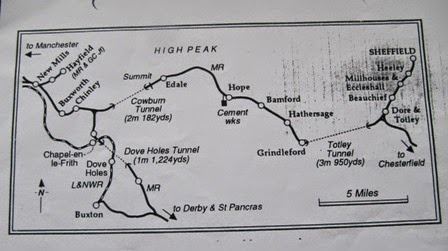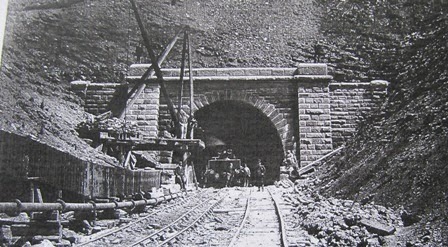Navvies on the Dore & Chinley Railway - lecture - Chesterfield - Derbyshire
http://www.aboutnottinghamshire.co.uk/
I just love tunnels - especially those over railway lines! I sit there thinking "How did they do this? Who were they? Where did they live?"
Consequently when I saw a poster advertising a talk by Clive Leivers about 'Navvies on the Dore & Chinley Railway' being given at the Chesterfield Labour Club I just had to be there!
 As if that wasn't enough Mr Leivers had also provided a large number of hand-outs, which he kindly said I could take and these form the basis for this blog, and all the illustrations, for which I am very grateful.
As if that wasn't enough Mr Leivers had also provided a large number of hand-outs, which he kindly said I could take and these form the basis for this blog, and all the illustrations, for which I am very grateful.
Leaving Sheffield railway station going west towards Manchester there are the most marvellous tunnels! The first one, that ends near Grindleford is 3 miles 950 yards long, and seems to go on forever! Further along the track, going through the High Peak area of Derbyshire is the shorter Cowburn Tunnel, just 2 miles 182 yards long.
 It was started in 1888, the line being over 20 miles long,and proved one of the most difficult in England to construct. The two tunnels meant that more than a quarter of the line is underground.
It was started in 1888, the line being over 20 miles long,and proved one of the most difficult in England to construct. The two tunnels meant that more than a quarter of the line is underground.
Mr Leivers had researched the occupations of those employed on this railway and interestingly there were 79 navvies, 184 railway labourers and 118 miners amongst the 476 men employed on the line. There were also 134 Craftsmen, including 26 brickmakers/bricklayers, 20 engine drivers and 44 stone masons - the latter apparently for bridge and tunnel entrance work.
Also it proved a myth that all navvies came from Ireland, for Mr Leivers analysis showed a surprisingly wide distribution, and whilst 39.4% came from the east midlands, so were presumably local people, others had come from as far away as East Anglia, and 26.5% from the south east.

 One thing I found very interesting was the huge importance of the Railway Mission. It was founded in 1881 with the intention of spreading the Christian Gospel to people working in the railways. One important aspect of their work was the publication of a magazine that advertised where the next line was being built, and as the workers were mainly itinerant this determined their next location.
One thing I found very interesting was the huge importance of the Railway Mission. It was founded in 1881 with the intention of spreading the Christian Gospel to people working in the railways. One important aspect of their work was the publication of a magazine that advertised where the next line was being built, and as the workers were mainly itinerant this determined their next location.
The conditions both at work and at home were generally pretty appalling, and whilst they mostly lodged with nearby fellow workers, the numbers using the same beds was staggering! Some also slept in rough sheds and inadequate shacks, and Inspectors feared there would be a cholera outbreak due to the complete lack of sanitary provisions. In fact there was a serious smallpox outbreak in 1893, with 23 cases, and 4 fatalities. Eventually a small hut had to be used as an Isolation Hospital.
 One thing that always marks the quality of a good lecture is how many people wanted to know more! One person asked if local businesses had benefited from the huge influx of workers on the railway, with Edale alone going from 336 in 1881, to nearly a thousand during the construction work. In this delightful photograph you can see eager children getting fish and chips from an enterprising van!
One thing that always marks the quality of a good lecture is how many people wanted to know more! One person asked if local businesses had benefited from the huge influx of workers on the railway, with Edale alone going from 336 in 1881, to nearly a thousand during the construction work. In this delightful photograph you can see eager children getting fish and chips from an enterprising van!
There was also a question as to whether any of the workers had married local girls. Mr. Leivers said it was hard to research this sort of thing, although there was a known case where a man from the south of England had certainly wed a local girl and settled in the area. They had twins, and called the girl Dore and the boy Chinley! The girl did not survive, but the man grew to be well-known in the area!
I found this lecture absolutely fascinating and was so glad I'd made the effort to attend. In fact there was so much interesting information I would quite like to hear Mr. Leivers again as I'm sure there are some details I missed!

I just love tunnels - especially those over railway lines! I sit there thinking "How did they do this? Who were they? Where did they live?"
Consequently when I saw a poster advertising a talk by Clive Leivers about 'Navvies on the Dore & Chinley Railway' being given at the Chesterfield Labour Club I just had to be there!
 As if that wasn't enough Mr Leivers had also provided a large number of hand-outs, which he kindly said I could take and these form the basis for this blog, and all the illustrations, for which I am very grateful.
As if that wasn't enough Mr Leivers had also provided a large number of hand-outs, which he kindly said I could take and these form the basis for this blog, and all the illustrations, for which I am very grateful.Leaving Sheffield railway station going west towards Manchester there are the most marvellous tunnels! The first one, that ends near Grindleford is 3 miles 950 yards long, and seems to go on forever! Further along the track, going through the High Peak area of Derbyshire is the shorter Cowburn Tunnel, just 2 miles 182 yards long.
 It was started in 1888, the line being over 20 miles long,and proved one of the most difficult in England to construct. The two tunnels meant that more than a quarter of the line is underground.
It was started in 1888, the line being over 20 miles long,and proved one of the most difficult in England to construct. The two tunnels meant that more than a quarter of the line is underground.Mr Leivers had researched the occupations of those employed on this railway and interestingly there were 79 navvies, 184 railway labourers and 118 miners amongst the 476 men employed on the line. There were also 134 Craftsmen, including 26 brickmakers/bricklayers, 20 engine drivers and 44 stone masons - the latter apparently for bridge and tunnel entrance work.
Also it proved a myth that all navvies came from Ireland, for Mr Leivers analysis showed a surprisingly wide distribution, and whilst 39.4% came from the east midlands, so were presumably local people, others had come from as far away as East Anglia, and 26.5% from the south east.

 One thing I found very interesting was the huge importance of the Railway Mission. It was founded in 1881 with the intention of spreading the Christian Gospel to people working in the railways. One important aspect of their work was the publication of a magazine that advertised where the next line was being built, and as the workers were mainly itinerant this determined their next location.
One thing I found very interesting was the huge importance of the Railway Mission. It was founded in 1881 with the intention of spreading the Christian Gospel to people working in the railways. One important aspect of their work was the publication of a magazine that advertised where the next line was being built, and as the workers were mainly itinerant this determined their next location.The conditions both at work and at home were generally pretty appalling, and whilst they mostly lodged with nearby fellow workers, the numbers using the same beds was staggering! Some also slept in rough sheds and inadequate shacks, and Inspectors feared there would be a cholera outbreak due to the complete lack of sanitary provisions. In fact there was a serious smallpox outbreak in 1893, with 23 cases, and 4 fatalities. Eventually a small hut had to be used as an Isolation Hospital.
 One thing that always marks the quality of a good lecture is how many people wanted to know more! One person asked if local businesses had benefited from the huge influx of workers on the railway, with Edale alone going from 336 in 1881, to nearly a thousand during the construction work. In this delightful photograph you can see eager children getting fish and chips from an enterprising van!
One thing that always marks the quality of a good lecture is how many people wanted to know more! One person asked if local businesses had benefited from the huge influx of workers on the railway, with Edale alone going from 336 in 1881, to nearly a thousand during the construction work. In this delightful photograph you can see eager children getting fish and chips from an enterprising van!There was also a question as to whether any of the workers had married local girls. Mr. Leivers said it was hard to research this sort of thing, although there was a known case where a man from the south of England had certainly wed a local girl and settled in the area. They had twins, and called the girl Dore and the boy Chinley! The girl did not survive, but the man grew to be well-known in the area!
I found this lecture absolutely fascinating and was so glad I'd made the effort to attend. In fact there was so much interesting information I would quite like to hear Mr. Leivers again as I'm sure there are some details I missed!

Published on April 10, 2014 03:53
No comments have been added yet.



